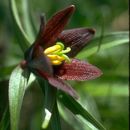en
names in breadcrumbs


Fritillaria camschatcensis is a species of flowering plant native to northeastern Asia and northwestern North America, including northern Oregon, Washington, British Columbia, Alaska, northern Japan, and the Russian Far East (Amur, Kamchatka, Khabarovsk, Magadan, Primorye, Sakhalin and the Kuril Islands).[2] It has many common names, including Kamchatka fritillary and Kamchatka lily.
It is also called rice lily, northern rice-root, or (misleadingly) Indian rice or wild rice, because of the rice-like bulblets that form around its roots.
Fritillaria camschatcensis produces bulbs with several large fleshy scales, similar to those of commercially cultivated garlic. Leaves are lanceolate, up to 10 cm long, borne in whorls along the stem. Stem is up to 60 cm tall, with flowers at the top. Flowers are spreading or nodding (hanging downwards), dark brown, sometimes mottled with yellow.[3][4][5][6]
Fritillaria camschatcensis is a species of flowering plant native to northeastern Asia and northwestern North America, including northern Oregon, Washington, British Columbia, Alaska, northern Japan, and the Russian Far East (Amur, Kamchatka, Khabarovsk, Magadan, Primorye, Sakhalin and the Kuril Islands). It has many common names, including Kamchatka fritillary and Kamchatka lily.
It is also called rice lily, northern rice-root, or (misleadingly) Indian rice or wild rice, because of the rice-like bulblets that form around its roots.